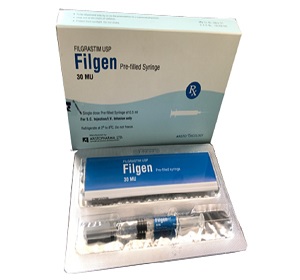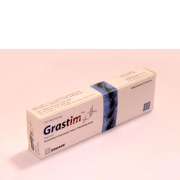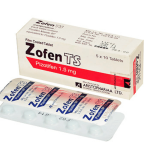Filgen (Filgrastim)
Filgen (Filgrastim) injection contains Filgrastim 30 MU (300 mcg) in 0.5 ml solution which is a Granulocyte Colony-Stimulating Factor (G-CSF).
Description
Filgrastim regulates the production of neutrophils within the bone marrow and affects neutrophil progenitor proliferation and differentiation. It also causes the enhanced phagocytic ability‚ priming of the cellular metabolism associated with respiratory burst‚ antibody-dependent killing and the increased expression of some cell surface antigens. Filgrastim is indicated for the treatment of neutropenia or febrile neutropenia.

Presentation
Each single-dose Filgen pre-filled syringe contains Filgrastim USP 30 MU (300 mcg) in 0.5 ml solution.
Indications
Filgen is indicated for –
- The decrease of the incidence of infection‚ as manifested by febrile neutropenia‚ in patients with nonmyeloid malignancies receiving myelosuppressive anticancer drugs associated with a significant incidence of severe neutropenia with fever.
- The reduction of the time to neutrophil recovery and the duration of fever, following induction or consolidation chemotherapy treatment of patients with acute myeloid leukemia (AML).
- The reduction of the duration of neutropenia and neutropenia-related clinical sequelae‚ e.g., febrile neutropenia, in patients with nonmyeloid malignancies undergoing myeloablative chemotherapy followed by bone marrow transplantation.
- The mobilization of autologous hematopoietic progenitor cells into the peripheral blood for collection by leukapheresis.
- The reduction of the incidence and duration of sequelae of neutropenia (e.g.‚ fever‚ infection or oropharyngeal ulcers) in symptomatic patients with congenital neutropenia‚ cyclic neutropenia or idiopathic neutropenia.
- The increase of the survival in patients acutely exposed to myelosuppressive doses of radiation (Hematopoietic syndrome of acute radiation syndrome).
- The prevention and treatment of persistent neutropenia (ANC < 1.0 x 109/l) in patients with advanced HIV infection, in order to reduce the risk of bacterial infections, when other options to manage neutropenia are inappropriate
Dosage & Administration
Cancer patients receiving myelosuppressive chemotherapy or induction and/or consolidation chemotherapy for AML: The recommended dose of Filgen is 0.5 MU (5 mcg)/kg/day, administered as a single daily subcutaneous injection or by intravenous infusion (over 30 minutes). The first dose shouldn’t be administered in less than 24 hours following cytotoxic chemotherapy. Continue until neutrophil count in normal range, usually for 14 days (up to 38 days in AML).
Cancer patients undergoing bone marrow transplantation: The recommended dosage of Filgen following bone marrow transplantation (BMT) is 1.0 MU (10 mcg)/kg/day given as an intravenous infusion no longer than 24 hours. Administer the first dose of Filgen at least 24 hours after cytotoxic chemotherapy and at least 24 hours after bone marrow transplantation. Dose adjustment should be accordingly to absolute neutrophil count (ANC).
Patients undergoing autologous peripheral blood progenitor cell (PBPC) collection and therapy: The recommended dosage of Filgen for the mobilization of autologous PBPC is 1.0 MU (10 mcg)/kg/day given by subcutaneous injection for 5-7 days. Administer Filgen for at least 4 days before the first leukapheresis procedure and continue until the last leukapheresis. Discontinue Filgen if the white blood cell (WBC) count rises to greater than 100‚000/mm3.
Patients with severe chronic neutropenia: The recommended starting dosage in patients with congenital neutropenia is 0.6 MU (6 mcg)/kg as a twice daily subcutaneous injection and with idiopathic or cyclic neutropenia is 0.5 MU (5 mcg)/kg as a single daily subcutaneous injection. Dose adjustment should be accordingly to ANC and complete blood count (CBC).
Patients acutely exposed to myelosuppressive doses of radiation (hematopoietic syndrome of acute radiation syndrome): The recommended dose of Filgen is 1.0 MU (10 mcg)/kg as a single daily subcutaneous injection for patients exposed to myelosuppressive doses of radiation.
Patients with HIV infection: The recommended starting dose of Filgen is 0.1 MU (1.0 mcg)/kg/day is given daily by subcutaneous injection with titration up
to a maximum of 0.4 MU (4 mcg) /kg/day until a normal neutrophil count is reached and can be maintained (ANC > 2.0 x 109/l).
Contrainidications
- With a history of serious allergic reactions to human granulocyte colony-stimulating factors such as Filgrastim or peg-Filgrastim.
- With severe congenital neutropenia (Kostmann’s syndrome) with abnormal cytogenetics.
- With known hypersensitivity to E-coli derived protein
Warning & Precautions
Pregnancy: Pregnancy category C. Filgrastim should be used during pregnancy only if the potential benefit justifies the potential risk to the fetus.
Nursing mothers: Caution should be exercised if Filgrastim is administered to women who are breast feeding.
Pediatric use: No age-related differences in the pharmacokinetics of Filgrastim were observed between these subjects and adult subjects.
Geriatric use: No overall differences in safety or effectiveness were observed between elder subjects (age: 65 or greater) and younger subjects.
Hepatic impaired patients: Studies of Filgrastim in patients with severe impairment of hepatic function demonstrate that it exhibits a similar pharmacokinetics profile to that seen in normal individual.
Renal impaired patients: Studies of Filgrastim in patients with severe impairment of renal function demonstrate that it exhibits a similar pharmacokinetics profile to that seen in normal individual.
Potential effect on malignant cells: The possibility that Filgrastim acts as a growth factor for any tumor type cannot be excluded.
Nuclear imaging: Filgrastim causes transient positive bone-imaging changes which should be considered when interpreting bone-imaging results.
Side effects
Most common side effects in patients –
- With nonmyeloid malignancies receiving myelosuppressive anti-cancer drugs are pyrexia, pain, rash, cough and dyspnea.
- With AML are pain, epistaxis and rash.
- With nonmyeloid malignancies undergoing myeloablative chemotherapy followed by BMT is rash.
- Undergoing peripheral blood progenitor cell mobilization and collection are bone pain, pyrexia and headache.
- With severe chronic neutropenia (SCN) are pain, anemia, epistaxis, diarrhea, hypoesthesia and alopecia
Drug interaction
Use in special groups
Packing
Storage:
Store Filgen at 2° to 8°C. Protect from sunlight and do not freeze. Avoid shaking. Prior to use allow Filgen to reach room temperature for a maximum of 24 hours. Discard any prefilled syringe left at room temperature for greater than 24 hours.
Presentation:
Each box contains 1 single dose Filgen pre-filled syringe in blister pack.




